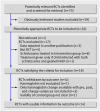Effect of administration of intestinal anthelmintic drugs on haemoglobin: systematic review of randomised controlled trials
- PMID: 17434954
- PMCID: PMC1877955
- DOI: 10.1136/bmj.39150.510475.AE
Effect of administration of intestinal anthelmintic drugs on haemoglobin: systematic review of randomised controlled trials
Abstract
Objective: To evaluate the effect of routine administration of intestinal anthelmintic drugs on haemoglobin.
Design: Systematic review of randomised controlled trials.
Data sources: Electronic databases and hand search of reviews, bibliographies of books, and abstracts and proceedings of international conferences.
Study selection: Included studies were randomised or quasi-randomised controlled trials using an intestinal anthelmintic agent in the intervention group, in which haemoglobin was evaluated as an outcome measure. Trials in which treatment for schistosoma (praziquantel) was given exclusively to the intervention group were excluded.
Results: The search identified 14 eligible randomised controlled trials. Data were available for 7829 subjects, of whom 4107 received an anthelmintic drug and 3722 received placebo. The pooled weighted mean difference (random effect model) of the change in haemoglobin was 1.71 (95% confidence interval 0.70 to 2.73) g/l (P<0.001; test for heterogeneity: Cochran Q=51.17, P<0.001; I(2)=61% (37% to 76%)). With the World Health Organization's recommended haemoglobin cut-offs of 120 g/l in adults and 110 g/l in children, the average estimated reduction in prevalence of anaemia ranged from 1.1% to 12.4% in adults and from 4.4% to 21.0% in children. The estimated reductions in the prevalence of anaemia increased with lower haemoglobin cut-offs used to define anaemia.
Conclusions: Routine administration of intestinal anthelmintic agents results in a marginal increase in haemoglobin (1.71 g/l), which could translate on a public health scale into a small (5% to 10%) reduction in the prevalence of anaemia in populations with a relatively high prevalence of intestinal helminthiasis.
Conflict of interest statement
Figures



Comment in
-
Intestinal nematode infection and anaemia in developing countries.BMJ. 2007 May 26;334(7603):1065-6. doi: 10.1136/bmj.39211.572905.80. BMJ. 2007. PMID: 17525401 Free PMC article.
-
Mass iron treatment is cheaper than routine deworming.BMJ. 2007 Jun 9;334(7605):1180. doi: 10.1136/bmj.39234.444259.3A. BMJ. 2007. PMID: 17556442 Free PMC article. No abstract available.
Similar articles
-
Transfusion thresholds for guiding red blood cell transfusion.Cochrane Database Syst Rev. 2021 Dec 21;12(12):CD002042. doi: 10.1002/14651858.CD002042.pub5. Cochrane Database Syst Rev. 2021. PMID: 34932836 Free PMC article.
-
WITHDRAWN: Anthelmintic drugs for treating worms in children: effects on growth and cognitive performance.Cochrane Database Syst Rev. 2007 Jul 18;(2):CD000371. doi: 10.1002/14651858.CD000371.pub2. Cochrane Database Syst Rev. 2007. Update in: Cochrane Database Syst Rev. 2007 Oct 17;(4):CD000371. doi: 10.1002/14651858.CD000371.pub3. PMID: 17636634 Updated.
-
Anthelmintic drugs for treating worms in children: effects on growth and cognitive performance.Cochrane Database Syst Rev. 2000;(2):CD000371. doi: 10.1002/14651858.CD000371. Cochrane Database Syst Rev. 2000. Update in: Cochrane Database Syst Rev. 2007 Jul 18;(2):CD000371. doi: 10.1002/14651858.CD000371.pub2. PMID: 10796537 Updated.
-
A systematic review and economic evaluation of epoetin alpha, epoetin beta and darbepoetin alpha in anaemia associated with cancer, especially that attributable to cancer treatment.Health Technol Assess. 2007 Apr;11(13):1-202, iii-iv. doi: 10.3310/hta11130. Health Technol Assess. 2007. PMID: 17408534
-
Folate supplementation in people with sickle cell disease.Cochrane Database Syst Rev. 2018 Mar 16;3(3):CD011130. doi: 10.1002/14651858.CD011130.pub3. Cochrane Database Syst Rev. 2018. PMID: 29546732 Free PMC article.
Cited by
-
Intestinal nematode infection and anaemia in developing countries.BMJ. 2007 May 26;334(7603):1065-6. doi: 10.1136/bmj.39211.572905.80. BMJ. 2007. PMID: 17525401 Free PMC article.
-
Toward the 2020 goal of soil-transmitted helminthiasis control and elimination.PLoS Negl Trop Dis. 2018 Aug 14;12(8):e0006606. doi: 10.1371/journal.pntd.0006606. eCollection 2018 Aug. PLoS Negl Trop Dis. 2018. PMID: 30106975 Free PMC article. No abstract available.
-
Hookworm-related anaemia among pregnant women: a systematic review.PLoS Negl Trop Dis. 2008 Sep 17;2(9):e291. doi: 10.1371/journal.pntd.0000291. PLoS Negl Trop Dis. 2008. PMID: 18820740 Free PMC article.
-
Study of helminthiasis in pregnancy and its correlation with haemoglobin level.J Clin Diagn Res. 2014 Oct;8(10):OC07-9. doi: 10.7860/JCDR/2014/10148.4931. Epub 2014 Oct 20. J Clin Diagn Res. 2014. PMID: 25478410 Free PMC article.
-
Association between water, sanitation, and hygiene access and the prevalence of soil-transmitted helminth and schistosome infections in Wolayita, Ethiopia.Parasit Vectors. 2022 Nov 4;15(1):410. doi: 10.1186/s13071-022-05465-7. Parasit Vectors. 2022. PMID: 36333779 Free PMC article.
References
-
- Joint statement by the World Health Organization and the United Nations Children's Fund. Focusing on anaemia: towards an integrated approach for effective anaemia control. 2004. .www.paho.org/English/AD/FCH/NU/WHO04_Anemia.pdf
-
- United Nations Administrative Committee on Coordination Sub-Committee on Nutrition (ACC/SCN). Fourth report on the world nutrition situation Geneva: ACC/SCN, International Food Policy Research Institute, 2000
-
- Mason JB, Lotfi M, Dalmiya N, Sethuraman K, Deitchler M, Geibel S, et al. The micronutrient report: current progress and trends in the control of vitamin A, iodine and iron deficiencies Ottawa: Micronutrient Initiative, 2001. (Available at www.micronutrient.org
-
- Gera T, Sachdev HPS, Nestel P, Sachdev SS. Effect of iron supplementation on hemoglobin response in children: systematic review of randomized control trials. J Pediatr Gastroenterol Nutr 2007. (in press). - PubMed
-
- World Health Organization. The millennium development goals: deworming. Geneva: WHO, 2005. (WHO/CDS/CPE/PVC/2005.1.)
Publication types
MeSH terms
Substances
LinkOut - more resources
Full Text Sources
